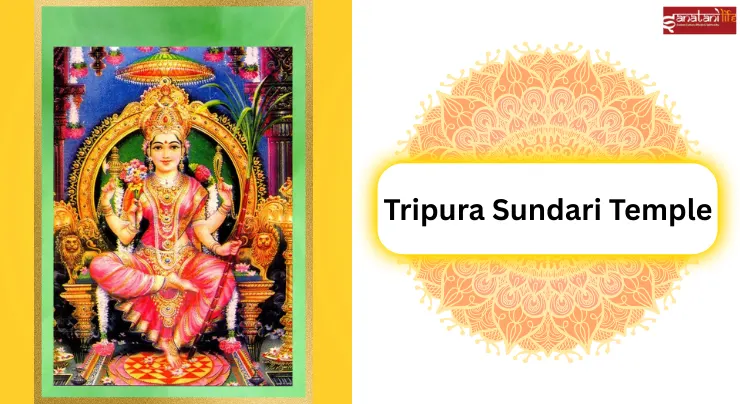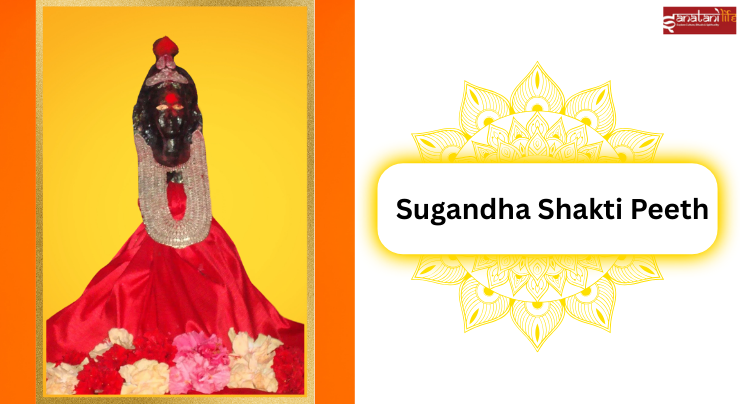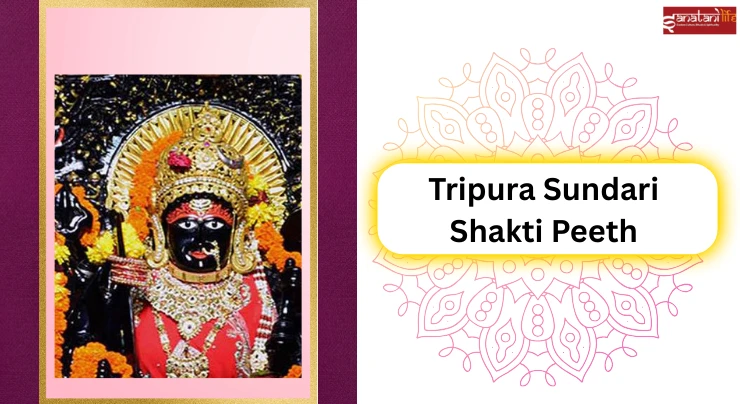Tripura Sundari Temple
Tripura Sundari Temple is a highly esteemed Hindu pilgrimage destination situated in Udaipur, India. This sacred site is one of the 51 Shakti Peeths, which are believed to be the locations where various body parts of Goddess Sati fell. The temple is dedicated to Tripura Sundari Shakti Peeth Temple, a prominent figure among the ten Mahavidyas and a formidable manifestation of Goddess Durga. It serves as a spiritual centre for devotees in search of divine blessings, tranquillity, and fulfilment.
Thank you for reading this post, don't forget to subscribe!The name Tripura Sundari means “The Beautiful Goddess of the Three Realms,” symbolising the goddess’s supreme power, elegance, and beauty. Renowned for her divine energy and importance within the Shakti tradition, she represents the ultimate feminine force that governs the cosmos. Pilgrims from across the globe visit this temple to receive her blessings for prosperity, health, and protection from malevolent influences.
The temple’s connection to the legend of Goddess Sati, who self-immolated in response to her husband Lord Shiva’s insult by her father, Daksha, imbues it with profound historical and mythological significance. As part of the revered 51 Shakti Peeths, the temple stands as a testament to the enduring power of the divine feminine and its lasting impact on Hindu spirituality.
Location of Tripura Sundari Temple
The Tripura Sundari Shakti Peeth Temple is situated in Udaipur, a town within the Gomati district of Tripura, India. Often referred to as the “City of Lakes,” Udaipur lies around 55 kilometres to the south of Agartala, the capital of the state. The temple is conveniently reachable by both road and rail, making it a favored destination for pilgrims from various parts of the country.
Set against a backdrop of tranquil lakes and natural beauty, the temple’s location enhances its spiritual atmosphere. Visitors, including both devotees and tourists, are drawn to Udaipur not only for the temple itself but also for the peacefulness and scenic allure of the area.
How to Reach Tripura Sundari Temple
- By Air: The closest airport is Agartala Airport (IXA), located approximately 55 kilometers from Udaipur.
- By Train: Udaipur Railway Station serves as the nearest railway hub, offering good connectivity to major cities in Tripura and adjacent states.
- By Road: Udaipur is well-linked by road to Agartala and other towns in Tripura. Transportation options such as taxis, buses, and private vehicles are readily available for those travelling to the temple.
Temple Timings
The Tripura Sundari Temple invites devotees to visit daily. The hours of operation are as follows:
Morning Darshan: 5:00 AM to 12:00 PM
Evening Darshan: 3:00 PM to 9:00 PM
Best Time to Visit Tripura Sundari Temple
The most favourable time to visit the Tripura Sundari Shakti Peeth Temple is during the cooler months, when the weather is pleasant and ideal for a tranquil pilgrimage:
- October to March – The climate during this period is cool and comfortable, making it the perfect time to experience the peaceful ambiance of the temple and its nearby attractions.
- Diwali (October–November) – This significant festival is one of the highlights of the temple’s calendar, as it is believed to be the goddess’s favored occasion. The temple is adorned with beautiful decorations, and special rituals are conducted, creating a magical atmosphere.
- Navratri (September–October) – This spiritually significant season features special rituals, prayers, and elaborate decorations, attracting a larger number of devotees.
- Durga Puja (September–October) – Celebrated with immense enthusiasm in Tripura, Durga Puja is a major event at the temple, drawing pilgrims from various regions to partake in the celebrations and offerings.
Mythological Importance of Tripura Sundari Temple
The Tripura Sundari Shakti Peeth Temple is of great mythological and spiritual importance within Hinduism, especially in the context of the Shakti Peeth tradition. Hindu mythology narrates that the goddess Sati, who was married to Lord Shiva, chose to self-immolate during a yagna hosted by her father Daksha, who had shown disrespect towards Shiva. In his profound sorrow and rage, Shiva roamed with Sati’s body until Lord Vishnu used his Sudarshan Chakra to dismember her corpse. The fragments of her body were scattered across various locations, which subsequently became known as Shakti Peeths.
At the Tripura Sundari site, it is believed that the left toe of Goddess Sati fell, establishing it as one of the most venerated Shakti Peeths in India. Here, the goddess is worshipped as Tripura Sundari, the enchanting deity representing the three realms: earth, atmosphere, and heaven. She is also linked to the Sri Vidya tradition, which emphasises the worship of the goddess through the sacred Sri Yantra.
The goddess is regarded as the embodiment of supreme feminine energy and cosmic strength. In the temple, she is depicted as a youthful and beautiful goddess, often called Shodashi, symbolising purity, wisdom, and spiritual potency. Consequently, the temple stands as a significant hub for the veneration of the divine feminine and holds particular relevance for practitioners of Tantric traditions.
The Right Foot at Tripura Sundari Temple
At the Tripura Sundari Shakti Peeth Temple, it is believed that the right foot of Goddess Sati fell, which contributes significantly to the temple’s spiritual importance. According to legend, during the dismemberment of Sati’s body by Lord Vishnu’s Sudarshan Chakra, her right foot landed at this site, establishing it as one of the most venerated locations among the 51 Shakti Peeths. The right foot symbolises the goddess’s divine protection and guidance. In Tantric traditions, it is often linked to the ability to eliminate obstacles and bestow devotees with wisdom, purity, and spiritual advancement. This foot is regarded as a powerful source, and devotees seek its blessings for both their spiritual and material prosperity.
Spiritual Significance of Tripura Sundari Shakti Peeth Temple
The Tripura Sundari Temple serves as more than a pilgrimage site; it stands as a significant hub of spiritual vitality and divine awareness. Devotees hold the belief that worshipping Maa Tripura Sundari at this location fosters inner tranquillity, material prosperity, and liberation (moksha).
As one of the 51 Shakti Peeths, this temple emanates the shakti tattva—the sacred feminine energy that sustains the universe. Pilgrims from various regions visit to seek the blessings of the goddess, who is regarded as the manifestation of Supreme Consciousness in a form that is both enchanting and compassionate.
Goddess of the Three Realms
The term Tripura Sundari translates to “The Beautiful One of the Three Cities” or realms—bhuloka (earth), antariksha (space), and swarga (heaven). She embodies the divine energy that permeates all three realms and is also revered as Shodashi, the eternally youthful goddess representing supreme beauty and wisdom.
A Central Deity in Tantra and Sri Vidya
This Shakti Peeth holds particular significance for followers of Sri Vidya, a highly esteemed and esoteric tradition of Tantric worship. The Sri Yantra—a mystical diagram symbolising the universe and the goddess herself—plays a crucial role in her veneration. Consequently, the temple is not merely a site of worship but also a dynamic spiritual centre for sadhaks (spiritual seekers), tantriks, and yogis.
Realisation of Aspirations and Elimination of Hindrances
Numerous devotees report experiencing the fulfilment of their desires, the removal of barriers, and significant life changes following their visits to the temple and earnest prayers. It is thought that Maa Tripura Sundari grants her devotees spiritual insight, emotional balance, and material abundance.
Temple Architecture and Design of Tripura Sundari Shakti Peeth Temple
The Tripura Sundari Temple represents a distinctive fusion of spiritual significance and regional architectural aesthetics. Situated on a modest hill, the temple features a square sanctum topped with a conical dome, reminiscent of the traditional Bengali hut-style known as chala architecture. Although it is relatively small, the temple radiates a profound spiritual presence that attracts thousands of worshippers throughout the year.
Main Sanctum and Deity
At the core of the temple is the sanctum sanctorum (garbhagriha), which enshrines the idol of Goddess Tripura Sundari, affectionately referred to as Maa Tripureshwari by the local community. Crafted from kasti stone, a unique reddish-black material, the idol is believed to be over 500 years old. The goddess is portrayed as a youthful figure (Shodashi) seated on a lion, wielding divine weapons. Notably, the Sri Yantra is placed beneath the idol, enhancing the temple’s status as a significant spiritual centre for Sri Vidya practitioners.
Sacred Pond: Kalyan Sagar
Adjacent to the temple lies Kalyan Sagar, a spacious holy pond that contributes to the temple’s allure. This pond is inhabited by rare species of tortoises and fish, and devotees consider feeding them to be a sacred act. The tranquil waters and picturesque surroundings further enhance the serene and spiritually uplifting atmosphere of the temple.
Simplicity and Sanctity
What distinguishes this temple is its unpretentiousness. It lacks extravagant embellishments or towering gopurams, instead showcasing the earthy sophistication of Tripura’s local culture, which allows the goddess’s spiritual energy to take precedence. Despite its age, the temple has been meticulously maintained and continues to stand as a prominent emblem of devotion, architectural beauty, and divine vitality.
Festivals and Celebrations at Tripura Sundari Temple
The Tripura Sundari Temple becomes a vibrant hub during significant Hindu festivals, drawing devotees from all over India and neighbouring nations. These events are not only grand but are also steeped in ancient traditions and spiritual importance.
Diwali – The Most Magnificent Celebration
The most prominent and colourful festival celebrated at the temple is Diwali. It is said that Tripura Sundari bestows her blessings upon her devotees during this festival of lights. The temple is adorned with numerous oil lamps, creating a celestial illumination that captivates all who behold it.
- Special pujas, bhajans, and aarti ceremonies are conducted.
- Thousands of devotees illuminate the temple grounds with diyas.
- The temple pond, Kalyan Sagar, mirrors the lights, enhancing the spiritual atmosphere.
Navratri and Durga Puja
Navratri, celebrated biannually, along with Durga Puja, are also significant occasions at the temple. These festivals pay homage to the various forms of Goddess Durga, with Tripura Sundari Temple being one of her most potent incarnations.
- During Navratri, the temple hosts nine days of intricate rituals dedicated to the nine avatars of Durga.
- Special yagnas, scripture recitations, and cultural performances are organised.
- The temple remains open late into the night, allowing devotees to pray and engage in the celebrations.
Other Observances
Kartik Purnima, Lakshmi Puja, and Guru Purnima are also celebrated with traditional rituals. Local fairs and spiritual gatherings are arranged during major events, fostering a festive and community-oriented atmosphere.
A Sacred Expedition to the Essence of Shakti
The Tripura Sundari Shakti Peeth Temple transcends being merely a holy location; it serves as a dynamic spiritual hub where mythology, devotion, and tranquillity intersect. As one of the most esteemed Shakti Peeths, this temple provides a deep connection to the divine feminine energy represented by Goddess Tripura Sundari, who epitomises beauty, wisdom, and cosmic strength.
With its ancient tales, strong Tantric heritage, peaceful environment, and lively festivals, every element of this temple resonates with the goddess’s presence. Whether you are a devotee in search of blessings, a spiritual explorer delving into profound truths, or a traveller captivated by India’s mystical heritage, visiting this temple promises to be a spiritually enriching experience.
Allow the divine essence of Tripura Sundari to illuminate your journey, bless your path, and awaken the Shakti within you. For further exploration of sacred sites, please refer to our article on the 51 Shakti Peeths.
FAQ of Tripura Sundari Temple
Q- Where can one find the Tripura Sundari Temple?
Ans- The temple is situated in Kailashahar, within the Unakoti district of Tripura, India, approximately 55 kilometers from Agartala, the capital of the state.
Q- What makes the Tripura Sundari Temple a Shakti Peeth?
Ans- According to Hindu mythology, it is believed that the right foot of Goddess Sati landed at this location, designating it as one of the 51 sacred Shakti Peeths where the divine feminine energy is honoured.
Q- When is the ideal time to visit the temple?
Ans- The optimal period for visiting is from October to March, particularly during festivals such as Diwali, Navratri, and Durga Puja, when the temple is most lively and spiritually enriched.
Q- Are there accommodations available in the vicinity?
Ans- Yes, there are various budget hotels, guesthouses, and government-operated lodges in both Kailashahar and Agartala for the convenience of pilgrims and visitors.
Q- Is photography permitted within the temple premises?
Ans- Photography may be limited in the sanctum sanctorum. It is advisable to consult with temple officials or observe posted signs before taking any photographs.
Q- Does the temple have connections to Tantric practices?
Ans- Indeed, the temple serves as a significant hub for Sri Vidya and Tantric worship, particularly esteemed by spiritual aspirants and practitioners.











